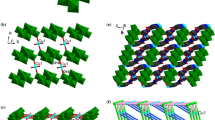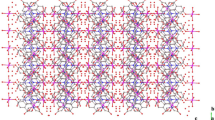Abstract
A new polyoxomolybdate/alkylamine composite (C3N2H5)6[As4Mo8O33]·4H2O [1] was successfully synthesized by controlling the reaction parameters in the conventional aqueous solution. Compound 1 was well characterized by single-crystal X-ray diffraction, FTIR, XPRD analysis, TGA and elemental analyses. It was found that compound 1 exhibited intriguing photochromic behavior along with interesting thermochromic property as the color of 1 turns from white to blue-mazarine with rise in temperature. Furthermore, compound 1 features distinct photochromic behavior in the solid state. This new arsenomolybdate/alkylamine composite can change color from white to pale blue upon irradiation by a xenon lamp (full wave-band, P = 300 W). The photochromism of 1 involves the reduction of Mo6+ to Mo5+, indicating crucial role in proton transfer from the imidazole cations toward the polyanion.







Similar content being viewed by others
References
Remón P, Bälter M, Li S, Andréasson J, Pischel U (2011) An all-photonic molecule-based D flip-flop. J Am Chem Soc 133:20742–20745
Credi A (2007) Molecules that make decisions. Angew Chem Int Ed 46:5472–5475
Mori K, Ishibashi Y, Matsuda H et al (2011) One-color reversible control of photochromic reactions in a diarylethene derivative: three-photon cyclization and two-photon cycloreversion by a near-infrared femtosecond laser pulse at 1.28 μm. J Am Chem Soc 133:2621–2625
Chen Z, Loo B-H, Ma Y et al (2004) Photochromism of novel molybdate/alkylamine composite thin films. ChemPhysChem 5:1020–1026
Ferri V, Elbing M, Pace G et al (2008) Light-powered electrical switch based on cargo-lifting azobenzene monolayers. Angew Chem 120:3455–3457
Yao X, Li T, Wang J et al (2016) Recent progress in photoswitchable supramolecular self-assembling systems. Adv Opt Mater 4:1322–1349
Wang M-S, Xu G, Zhang Z-J, Guo G-C (2010) Inorganic–organic hybrid photochromic materials. Chem Commun 46:361–376
Zhang Z-J, Xiang S-C, Guo G-C et al (2008) Wavelength-dependent photochromic inorganic–organic hybrid based on a 3D iodoplumbate open-framework material. Angew Chem Int Ed 47:4149–4152
Ke X, Yan X, Song S et al (2007) Synthesis and characterization of a photochromic sol–gel material functionalized with azo dye. Opt Mater 29:1375–1380
Volkan M, Stokesa D-L, Dinha V-T (2005) A sol–gel derived AgCl photochromic coating on glass for SERS chemical sensor application. Sens Actuators B Chem 106:660–667
He T, Yao J (2006) Photochromism in composite and hybrid materials based on transition-metal oxides and polyoxometalates. Prog Mater Sci 51:810–879
Coué V, Dessapt R, Bujoli-Doeuff M et al (2007) Synthesis, characterization, and photochromic properties of hybrid organic–inorganic materials based on molybdate, DABCO, and piperazine. Inorg Chem 46:2824–2835
Wei F, Tie R, Zhang Y-L et al (2003) Photochromic behavior of nanocomposite hybrid films of finely dispersed phosphotungstic acid particles into polyacrylamide. J Mater Sci 38:1045–1048. doi:10.1023/A:1022302031156
Yamase T, Ikawa T, Kokado H et al (1973) Photochromism of dimethylammonium molyedate. Chem Lett 2:615–616
Liang Y, Li S, Yang D et al (2015) Controllable assembly of multicarboxylic acids functionalized heteropolyoxomolybdates and allochroic properties. J Mater Chem C 3:4632–4639
Yang L, Zhou Z, Ma P-T et al (2013) Three organic–inorganic hybrid B-Anderson polyoxoanions as building blocks: syntheses, structures, and characterization of [(C6H5NO2)2Ln(H2O)6](CrMo6O24H6)·2C6H5NO2·6H2O (Ln = Sm, Dy, Er). J Coord Chem 66:1058–1067
Hakouk K, Oms O, Dolbecq A et al (2013) Sulfonium polyoxometalates: a new class of solid-state photochromic hybrid organic–inorganic materials. Inorg Chem 52:555–557
Zhang H, Duan L, Lan Y et al (2003) Synthesis, crystal structure, and photochromism of novel two-dimensional supramolecular networks based on Keggin-type polyoxoanion and lanthanide coordination cations. Inorg Chem 42:8053–8058
Sang X, Li J, Zhang L et al (2014) A novel carboxyethyltin functionalized sandwich-type germanotungstate: synthesis, crystal structure, photosensitivity, and application in dye-sensitized solar cells. ACS Appl Mater Interfaces 6:7876–7884
Li J-S, Sang X-J, Chen W-L et al (2015) Enhanced visible photovoltaic response of TiO2 thin film with an all-inorganic donor–acceptor type polyoxometalate. ACS Appl Mater Interfaces 7:13714–13721
Han X-B, Zhang Z-M, Zhang T et al (2014) Polyoxometalate-based cobalt–phosphate molecular catalysts for visible light-driven water oxidation. J Am Chem Soc 136:5359–5366
Kumar A, Devi M, Mamidi N et al (2015) Aromatic sulfonium polyoxomolybdates: solid-state photochromic materials with tunable properties. Chem—Eur J 21:18557–18562
Wang Y, Li H, Wu C et al (2013) Chiral heteropoly blues and controllable switching of achiral polyoxometalate clusters. Angew Chem Int Ed 52:4577–4581
Fidalgo E-G, Neels A, Evans H-S et al (2002) New iso and heteropolyoxomolybdates: synthesis and molecular structure of the anions [Mo VI8 O26(OH)]5, [HAsIIIAsVMoVMo VI8 O34]6 and [HAsIIIAsVMoVMo VI8 O34{Co(C5H5N)2(H2O)3}]4. Polyhedron 21:1921–1928
Li L, Liu B, Xue G et al (2009) Three hybrid organic–inorganic assemblies based on different arsenatomolybdates and CuII–organic units. Cryst Growth Des 9:5206–5212
He Q, Wang E, You W et al (1999) Hydrothermal synthesis and structure of [AsIIIAsVMo VI9 O34]6−, a monocapped, trivacant Keggin species. J Mol Struct 508:217–221
Sheldrick G-M (2008) A short history of SHELX. Acta Crystallogr A 64:112–122
Niu J, Hua J, Ma X, Wang J (2012) Temperature-controlled assembly of a series of inorganic–organic hybrid arsenomolybdates. CrystEngComm 14:4060–4067
Bondarenko V, Brill JW, Dumas J, Schlenker C (2004) Specific heat anomalies in the quasi two-dimensional monophosphate tungsten bronzes K x P4W8O32. Solid State Commun 129:211–215
Cai L-Z, Chen Q-S, Zhang C-J et al (2015) Photochromism and photomagnetism of a 3d–4f hexacyanoferrate at room temperature. J Am Chem Soc 137:10882–10885
Yamase T (1998) Photo- and electrochromism of polyoxometalates and related materials. Chem Rev 98:307–325
Dolbecq A, Dumas E, Mayer CR, Mialane P (2010) Hybrid organic–inorganic polyoxometalate compounds: from structural diversity to applications. Chem Rev 110:6009–6048
Ma P, Hu F, Wan R et al (2016) Magnetic double-tartaric bridging mono-lanthanide substituted phosphotungstates with photochromic and switchable luminescence properties. J Mater Chem C 4:5424–5433
Papaconstantinou E (1989) Photochemistry of polyoxometallates of molybdenum and tungsten and/or vanadium. Chem Soc Rev 18:1–31
Wang J, Liang Y, Ma P et al (2017) Ligand-controlled formation of covalently modified antimoniomolybdates and their photochromic properties. CrystEngComm 19:207–213
Xu G, Guo G-C, Wang M-S et al (2007) Photochromism of a methyl viologen bismuth(III) chloride: structural variation before and after UV irradiation. Angew Chem Int Ed 46:3249–3251
Dessapt R, Collet M, Coué V et al (2009) Kinetics of coloration in photochromic organoammonium polyoxomolybdates. Inorg Chem 48:574–580
Yang D, Li S, Ma P et al (2013) Carboxylate-functionalized phosphomolybdates: ligand-directed conformations. Inorg Chem 52:8987–8992
Acknowledgements
We gratefully acknowledge support from the NSFC (Grant 21571050) and Natural Science Foundation of Henan Province (Grant 162300410015).
Author information
Authors and Affiliations
Corresponding authors
Electronic supplementary material
Below is the link to the electronic supplementary material.
Rights and permissions
About this article
Cite this article
Lu, J., Zhang, X., Ma, P. et al. Photochromic behavior of a new polyoxomolybdate/alkylamine composite in solid state. J Mater Sci 53, 3078–3086 (2018). https://doi.org/10.1007/s10853-017-1736-8
Received:
Accepted:
Published:
Issue Date:
DOI: https://doi.org/10.1007/s10853-017-1736-8




